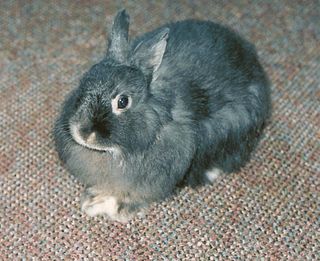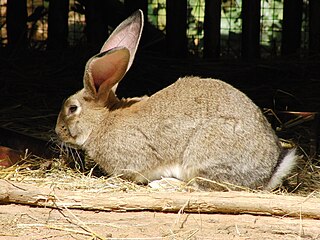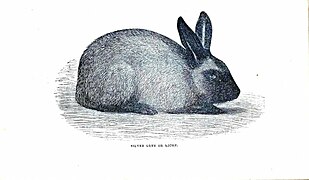
The Angora rabbit, one of the most ancient groups of domestic rabbit breeds, which is bred for the long fibers of its coat, known as Angora wool. They are gathered by shearing, combing or plucking. Because rabbits do not possess the same allergy-causing qualities as many other animals, their wool is an important alternative. There are at least 11 distinct breeds of Angora rabbit, four of which are currently recognized by the American Rabbit Breeders Association (ARBA): the English Angora, the French Angora, the Giant Angora and the Satin Angora. Other unrecognized breeds include the German Angora, the Finnish Angora, the Chinese Angora, the Japanese Angora, the Korean Angora, the Russian Angora, the St Lucian Angora and the Swiss Angora.

The Netherland Dwarf is a breed of domestic rabbit that originated in the Netherlands. Weighing 1.1–2.5 pounds (0.50–1.13 kg), the Netherland Dwarf is one of the smallest rabbit breeds. Its popularity as a pet or show rabbit may stem from its neotenic appearance. The Netherland Dwarf is recognised by both the American Rabbit Breeders Association (ARBA) and the British Rabbit Council (BRC). The Netherland Dwarf is often confused with the Polish breed of rabbit, but the latter has longer ears, a non-brachycephalic head and less cobbiness.

The Jersey Wooly is a breed of domestic rabbit weighing about 3 pounds with a bold head and wool fur on their body.

The Holland Lop is a breed of lop-eared rabbit that was recognized by the American Rabbit Breeders Association (ARBA) in 1979. The Holland Lop, with a maximum weight of 1.8 kg (4 lb), is one of the smallest lop-eared breeds.

The American Fuzzy Lop is a rabbit breed recognized by the American Rabbit Breeders Association (ARBA). It is similar in appearance to a Holland Lop. However, the American Fuzzy Lop is a wool breed and will have wool similar to the Angora breeds although the wool will be shorter than that of a commercial Angora. The American fuzzy lop has to weigh up to four pounds in order to be shown.

The Flemish Giant rabbit is the largest breed of domestic rabbit. They weigh 6.8 kilograms on average, though the largest ones can weigh up to 22 kilograms. Historically they are a utility breed used for their fur and meat. In the modern day, they are no longer commonly raised for meat, due to their slow growth and very large bones, and are raised for exhibition at rabbit shows. They are often kept as pets as they are known for being docile and patient when being handled.

The French Lop is a breed of domestic rabbit developed in France in the 19th century from the selective breeding of English Lop and Flemish Giant stock. The French Lop resembles the English Lop, but the French Lop is heavier in stature and does not have the exaggerated ear length of the English Lop. Weighing approximately 4.98 kg to 5.21 kg, it has an average lifespan of five to seven years. The French Lop is currently recognized by the American Rabbit Breeders Association (ARBA) and by the British Rabbit Council (BRC).

The sumxu, Chinese lop-eared cat, drop-eared cat, droop-eared cat, or hanging-ear cat, all names referring to its characteristic feature of pendulous ears, was a possibly mythical, long-haired, lop-eared type of cat or cat-like creature, now considered extinct, if it ever actually existed. The descriptions are based on reports from travellers, on a live specimen reportedly taken to Hamburg by a sailor, and on a taxidermy specimen exhibited in Germany. The cats were supposedly valued as pets, but was also described as a food animal. The last reported Chinese lop-eared cat was in 1938. It is believed by some to have been a mutation similar to that found in the Scottish Fold. The name sumxu originally described the yellow-throated marten, but a series of mistranslations caused the name to be applied to the alleged cat or cat-like animal.

The term rex rabbit refers informally to one of at least eight breeds of domestic rabbit. One such breed is the Rex, which is recognized by the American Rabbit Breeders Association (ARBA) and by the British Rabbit Council (BRC). Other modern-day rex rabbit breeds are listed below. Care must be taken to distinguish the rex rabbit breeds from the three types of rex rabbit fur for which they are known.

The Argenté rabbit is one of the oldest breeds of French show rabbits. The British Rabbit Council (BRC) recognises six varieties: Argenté Bleu, Argenté Brun, Argenté Crème, Argenté de Champagne, Argenté Noir, and Argenté St Hubert. The American Rabbit Breeders Association (ARBA) recognises the Champagne d'Argent, the Crème d'Argent and the Argenté Brun. A rare variety, the Argenté Clair, is not currently recognised by either the BRC or ARBA.
The English Lop is a fancy breed of domestic rabbit that was developed in England in the 19th century through selective breeding. It is believed to be the first breed of lop rabbit developed by humans, and it may be one of the oldest breeds of domestic rabbit. Averaging 5.5 kg (12 lb), the English Lop is characterised by its distinctively long lop ears, bold head, and large body size.
Plush Lop is a breed of domestic rabbit with two varieties: Miniature and Standard. There is also a Canadian Plush Lop breed in development. Similar in appearance, the Velveteen Lop breed is also in development. Miniature Plush Lops were the first to be developed. Devie D'anniballe began creating this breed in 1995 in the United States. She succeeded in developing them by combining the previously existing breeds of Holland Lop, Mini Rex, and Mini Lop. Her aim was to create the perfect pet by retaining the good qualities of these breeds, while "breeding out" all the problems existing in these breeds.

Miniature Lop is a breed of domestic rabbit recognised by the British Rabbit Council (BRC). Confusion arises because, in the UK, the Miniature Lop is often commonly called the Mini Lop. It is, however, a different breed from the Mini Lop that is recognized by the American Rabbit Breeders Association (ARBA). The BRC-recognized Miniature Lop is most similar to the ARBA-recognized Holland Lop. The Miniature Lop is also similar to several other small rabbit breeds.

The Miniature Lion Lop is a breed of domestic rabbit recognised by the British Rabbit Council. The breed is not currently recognized by the American Rabbit Breeders Association. In addition to its lop ears, the distinguishing feature of this breed is its Lionhead-type mane and its small size: 1.5–1.6 kilograms (3.3–3.5 lb).

Dwarf Hotot is a breed of domestic rabbit characterized by an entirely white coat, except for a circle of another color around each eye.
The Velveteen Lop is a breed of lop-eared rabbit developed from Mini Rex and English Lop ancestry in the United States from the late 1980s through early 1990s. It is the first American rabbit breed to combine lopped ears and rex fur. Velveteens are known to have friendly, gentle personalities. They are medium-sized rabbits weighing 5 to 7 pounds when fully grown and come in a wide variety of coat colors.
The Blue Imperial rabbit was an English breed of domestic rabbit that is now extinct. It was originally bred by Miss Mabel Illingworth (1879-1955), who was the first woman to create a rabbit breed. It was used to create several modern breeds, including the American rabbit.

















